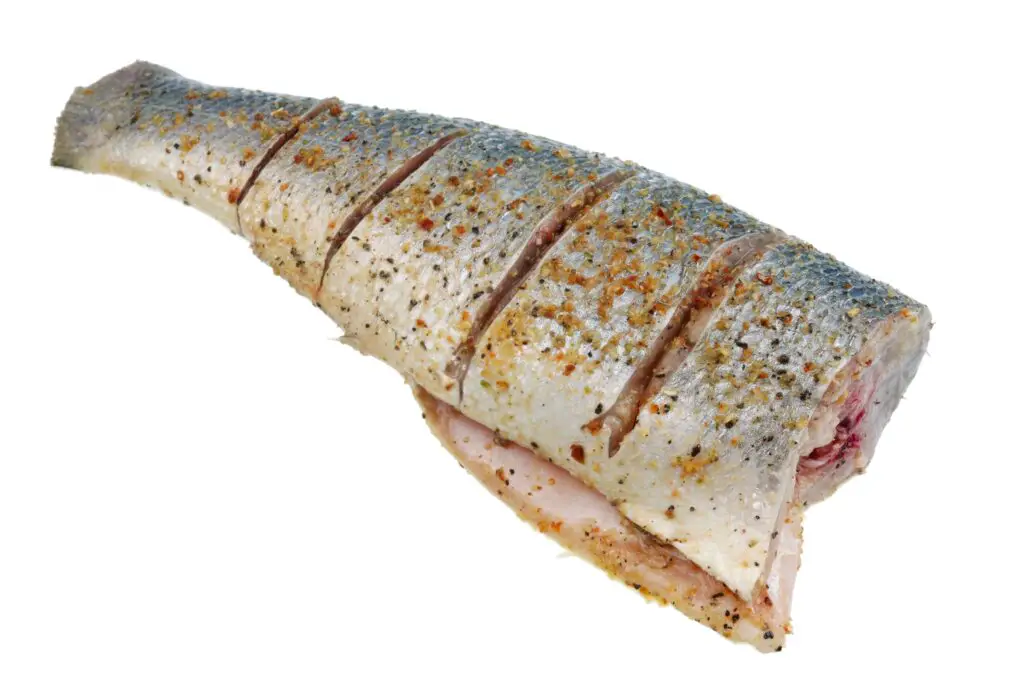The skin of the grouper is edible. Grouper skin has a crunchy bite when cooked properly. Besides, grouper skin is safe to eat. Omega-3 fatty acids, which support both physical and mental health, are present in grouper and may be found in both the skin and the meat.

Do You Have to Skin the Grouper?
In particular, the skin of the grouper shrinks significantly while cooking, which can cause the fillet to curl forcefully. Yet it is crispy and delicious, so gently score it with a sharp knife if you want to keep the skin on. It also goes without saying that the skin must be scaled.
At restaurants all throughout the world, grouper is a fish that is highly regarded. Its flavor is subtle, and its texture is firm. It is frequently served grilled, fried, broiled, baked, or steam cooked. Grouper is high in protein and low in mercury. It is always recommended to eat low-mercury seafood.
Is Eating Fish Skin, Okay?
Fish skin is generally safe to consume. However, some people might avoid eating it out of concern for their health. Throughout history, eating fish skin has been safe. Many nations and civilizations regard it as a common snack. The skin of most fish is usually acceptable to eat as long as it has been thoroughly washed and the outside scales have been eliminated. Fish is a fantastic source of vitamins and minerals, including iron and omega-3 fatty acids, and the Food and Drug Administration (FDA) suggests eating a 4-ounce (113-gram) meal of fish two to three times each week.
Yet, certain fish have significant concentrations of mercury as well as other toxins and pollutants, all of which can be found in the skin. In light of this, selecting low-mercury fish more frequently than high-mercury fish is advised. Here are a few instances of fish with average mercury levels:
-
- Low: catfish, cod, flounder, pollock, salmon, tilapia, most canned tunas
-
- Medium: carp, grouper, halibut, mahi-mahi, snapper
-
- High: king mackerel, marlin, shark, swordfish, tilefish
In other words, eating fish flesh has health hazards comparable to or greater than those posed by eating fish skin. When choosing the fish to eat, follow the same rules you would when picking the fish’s skin.
The Benefits of Eating Fish Skins
The best-kept secret in seafood is fish skins. When done properly, the most delectable component of a fish fillet is its crispy skin. Here are some reasons why you should consider consuming more fish skin in your diet, whether it comes in the form of skin-on fillets or expertly cooked fish skins.
Fish Skins Have a High Level of Omega-3
Many fish species are excellent suppliers of Omega-3s, as you’ve probably heard. Polyunsaturated fat has been demonstrated to lower inflammation and is essential for maintaining cardiovascular health and cell repair. Although the fillet of fish contains the majority of omega-3 fatty acids, there is also some of this much-needed fatty acid in the skin.
Safe to Eat Fish Skins
Knowing where your fish comes from is crucial because a fish’s skin is exposed to its surroundings and pollution. Avoid consuming wild or farmed fish that comes from contaminated areas or farms that utilize antibiotics and pesticides. Whether you choose to eat the skin or not, this is an excellent habit to get into.
You’ll appear younger with fish skin
Fish collagen, one of the more accessible forms of type 1 collagen, is made from the skin, scales, and bones of freshwater and saltwater fish. Fish collagen is a protein that keeps the skin, blood vessels, gums, eyes, nails, and hair strong and flexible. It also helps to maintain the skeletal system, including the bones, tendons, ligaments, joints, and muscles. For healthy skin and strength maintenance, type 1 collagen is necessary. Collagen must be consumed as part of a healthy diet to prevent the negative consequences of aging since, as we age, our bodies become less able to produce it.
Health Benefits and Nutrition of Grouper Skin
Depending on the type of fish, the precise nutritional composition of fish skin varies greatly. Yet, a few essential elements are abundant in most fish. Eating the skin of grouper, both fatty and lean, can help maintain an appropriate nutrient intake of the following nutrients:
-
- Protein
-
- Omega-3 fatty acids
-
- Vitamin D
-
- Vitamin E
-
- Iodine
-
- Selenium
-
- Taurine
Is Grouper’s Skin Edible?
Snapper is a lean, low-fat fish with a mild flavor and edible skin. It is all suitable for human consumption. Since you can eat snapper skin after it has been scaled, it tastes something like a crispy potato chip. The rough and flavorful skin should be removed before cleaning. Due to its nutritional value in addition to its deliciousness, grouper has also gained popularity among consumers interested in eating healthily.
How Should Groupers Be Prepared for Eating?
The most common method of preparing this wonderful fish is pan-frying. The filets should be rubbed with butter or olive oil and your preferred seasonings after being defrosted. Then, cook with half an inch of cooking oil over high heat in a skillet with a thick bottom or made of cast iron.
Is grouper a nutritious fish?
Grouper is a great source of high-quality protein and other healthy fats, and it is low in saturated fat, which should make up no more than 10% of daily calories and which, if consumed in excess, can be harmful to the heart and arteries.
Bottom Line
-
- As long as it has been thoroughly washed and the outer scales have been removed. The nutrients included in fish skin, such as protein, omega-3 fatty acids, and vitamin E, can support skin health, heart health, and muscle growth.
-
- Mercury is a heavy metal that, in large concentrations, can be harmful to your health, and grouper skin may contain mercury. Growing children whose bodies and brains are still developing, are particularly vulnerable to the dangers of mercury. It’s critical to understand where your fish is coming from.
-
- Avoid consuming fish from farms that employ antibiotics and chemicals or fish that have been captured in the wild from highly contaminated places.












Pingback: What Is the Difference Between Grouper and Skate? | Reel Fishing Guru
Pingback: What Is the Difference Between Grouper and Eel? | Reel Fishing Guru